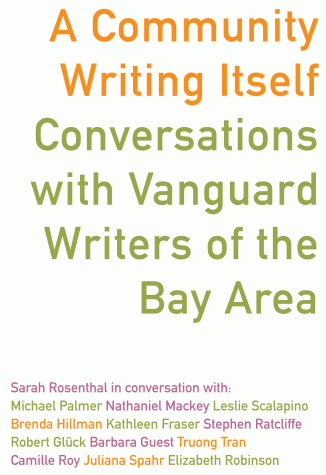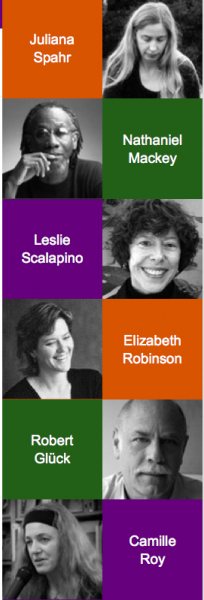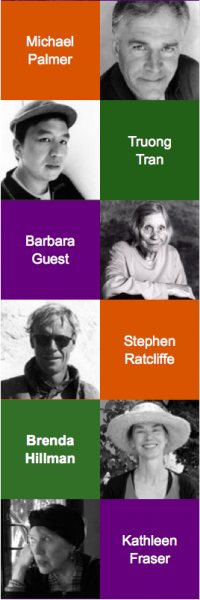A global regional poetics
A review of 'A Community Writing Itself'

A Community Writing Itself: Conversations with Vanguard Writers of the Bay Area
A Community Writing Itself: Conversations with Vanguard Writers of the Bay Area
The literary interview is a genre whose value is as likely to be taken for granted as it is ignored. Yet at their best, interviews with writers can be unique sources of knowledge. More casual than scholarly essays and often less packed with specialized vocabulary, literary interviews, when done well, can cover quite a range: information about writers’ lives and feelings about their lives; precise details about composition; essential historical context for thinking about writers’ works; chances for writers to talk about what they think their writing has most essentially explored.
A Community Writing Itself: Conversations with Vanguard Writers of the Bay Area manages to do all these things. It’s an insightful, serious, and entertaining collection that makes a significant contribution to understanding what has been going on in Bay Area writing for the last forty years. But it’s not just for readers interested in Bay Area literature. It also engages many aesthetic, social, political, and cultural questions that are national and global in scope.
A Community Writing Itself opens with a detailed yet compact introduction whose first twenty pages summarize nicely the history of Bay Area innovative writing, including its nineteenth-century roots in such nonconformist figures as Mark Twain and Joaquin Miller. The introduction’s second part highlights what Rosenthal sees as the most commonly recurring issues in the interviews.
The first part reads like a well-designed encyclopedia entry. It’s in the nature of encyclopedic summaries that  people can quibble about this or that characterization, as writers like Ron Silliman and a few others have already done, inevitably, with this book. But Rosenthal’s history is solid, marking most of the key moments in the poetry of the region.
people can quibble about this or that characterization, as writers like Ron Silliman and a few others have already done, inevitably, with this book. But Rosenthal’s history is solid, marking most of the key moments in the poetry of the region.
That said, little of the introduction’s information will come as news to anyone well read in the history of Bay Area writing, which means that the summary is perhaps most useful for readers still learning about that history. Still, Rosenthal’s introduction is as good a summary of Bay Area vanguard literature as has yet been written. And the key themes she highlights from the interviews make useful guideposts that hardly exhaust what the writers say about those themes in the interviews.
The only potentially significant problem with the introduction is not so much that this or that stitch is dropped or ever so slightly misrepresented as that the introduction seems more targeted at uninformed readers than the interviews. Rosenthal, like all excellent interviewers, has read closely and well the work of the people she interviews. The resulting conversations often examine the writers’ work and lives with the close analysis skills evident in the best critical writing. While it’s not necessary that readers of A Community Writing Itself know the work of the interviewed writers as well as Rosenthal, many insights in the interviews depend on having some understanding of these writers’ works. The issue is less one of the quality of either section of the book than of the mismatch between them. However, even for an informed reader, the summarized history of Bay Area vanguard literature is a pleasure.
Many of Rosenthal’s questions come from her responses to specific books or to lines in the work of the writer being interviewed. The specificity of Rosenthal’s questions lend themselves to informative responses, ones that at their best are unexpected and surprising. There is something of a formula to Rosenthal’s interview approach, which usually moves chronologically through specific books and historical moments and finally arrives at questions about Bay Area writing communities. On the whole, the formula is a fine one, but Rosenthal is also varied and nimble enough in her interplay with those she interviews that it rarely seems like the interview is following a checklist.
No matter how excellent one’s questions, interviews are rarely more interesting than the people being interviewed. One thing that A Community Writing Itself shows is the impressive range of interests and knowledge among Bay Area vanguard writers. Rosenthal has done an especially good job of arranging the order of the interviews to highlight differences, with each interview working as a juxtaposition to those before and after it.
Kathleen Fraser talks a great deal in the collection’s first interview about the emotional, intellectual, and cultural struggles behind the creation of her books, struggles which all concern gender. The conversation moves geographically between Fraser’s experiences as a cultural outsider in Italy and as a woman in the Bay Area who worked not just to establish a distinctly feminist poetics, as well an academic and cultural environment in which feminists could be heard, but also to create any recognition whatsoever of the significance of gender to literature. The Bay Area is rightly considered one of the most progressive cultural environments in the US, and it’s important to remember that even in that progressive environment, as little as forty years ago there was no institutional support, and even little personal support, for women writers.
Fraser’s experiences contrast usefully with Robert Glück’s discussion, in the next interview, of the day-to-day political and cultural struggles of Bay Area writers and communities, most significantly through the 1980s. Glück describes vividly the often hotly argued differences between Language poets and New Narrative writers, many of which had to do with differences between straight and gay political concerns. Glück makes clear that the literary elements of those discussions didn’t take place in some New Critical vacuum. Instead, the discussions happened in the context of larger questions of local and global power structures in which Bay Area writers were and are enmeshed.
While both Fraser and Glück have worked against white male heterosexual power and approaches to literature, and have made crucial efforts at creating communities open to alternative approaches, those similarities play out very differently in the interviews. Glück discusses innovative ways of describing persons and their struggles with each other, while Fraser focuses on textual mechanics that allow her to portray various types of voiceless, partially voiced, or multiply voiced dynamics in terms of the physical space of the page.
The interv iews that follow expand this range of concerns, and a review like this can mention only some basic ones. The late Barbara Guest, in perhaps her last interview, is understated and even minimalist in her discussion of poetry’s involvement with the worldly and the spiritual. Brenda Hillman takes up intriguing connections between mysticism, religion, science, and geography. Nathaniel Mackey elaborates at some length on the historical and cultural framework for the unique mythology that has continued to grow larger over the course of his books. Michael Palmer takes up the important question of how to keep literary experimentation from becoming its own self-defining historical niche removed from the problem of engaging people not already involved in experimental writing communities.
iews that follow expand this range of concerns, and a review like this can mention only some basic ones. The late Barbara Guest, in perhaps her last interview, is understated and even minimalist in her discussion of poetry’s involvement with the worldly and the spiritual. Brenda Hillman takes up intriguing connections between mysticism, religion, science, and geography. Nathaniel Mackey elaborates at some length on the historical and cultural framework for the unique mythology that has continued to grow larger over the course of his books. Michael Palmer takes up the important question of how to keep literary experimentation from becoming its own self-defining historical niche removed from the problem of engaging people not already involved in experimental writing communities.
Stephen Ratcliffe and Leslie Scalapino (who, sadly for all of us who knew her or her work, died while I was writing this review) have a great deal in common in their self-aware attempts to define phenomenologies not limited to conventional notions of culture and perception. Ratcliffe focuses on the moment and dynamics of perception itself, while Scalapino, fascinatingly and ambitiously and in a troubled way (trouble she acknowledges and courts), tries to lodge perception and culture in a physical condition in which the primacy of any framework must always be questioned by other ways of being and seeing.
Elizabeth Robinson talks thoughtfully about the resistance she encounters to being a Christian poet who is at the same time refashioning Christian and literary traditions for new needs, although her interview left me wondering where specifically Robinson’s work takes up Christianity as such more than as a broad, generous sense of the sacred and the spiritual. Juliana Spahr talks about race and gender and the complicity of all US poets in power dynamics larger than themselves.
In the book’s final interview, Truong Tran discusses the way his work has moved between telling stories that he feels are of crucial cultural or personal importance and a more experimental fragmentation that acknowledges limits on storytelling and representational writing. He talks insightfully about ways of portraying information that don’t claim more absolute ground for that information than he has.
While knowing these writers’ work will help readers of A Community Writing Itself, informed readers create a further difficulty for the dynamic of an interview. Interviews always run the risk of writers saying no more than the things one might expect them to say. It’s important that an interview add to the information already known about a given writer, whether through new perspectives or, just as crucially, moments of surprise, when even informed readers might not have seen the remark coming.
Often enough, the interviews in the book provide no more than the pleasure of the expected, but one of the best things about A Community Writing Itself is that there are many genuinely surprising moments, when writers answer questions in unexpected ways that may even startle themselves and can certainly startle readers who think they know what they’re going to get.
Camille Roy’s interview, one of the most energetic and to my mind successful in the book, works so well because of Roy’s willingness to go against the grain of accepted experimental conventions. Perhaps the most surprising moment in the book comes when she says,
Sometimes I think men can relate to what I’m doing more than women can. I think women, because they feel frightened, have a desire to live in a world that is safe. (260)
Similarly noteworthy are moments in Leslie Scalapino’s interview when she becomes, if not quite embarrassedly self-conscious, at least aware that the way she writes and talks could easily veer into chaotic incoherence if she isn’t careful:
I wanted the writing to be itself attention … so that the writer wouldn’t forcibly exclude anything, and the reader would let it come in, but the writing would also be very clear and attentive so it wouldn’t be crazy-making. (277)
Or, similarly:
This is something that’s very hard to describe. It’s as if the dreams that you have at night are in the day, and there’s no difference between night and day, because the dreams are projected out in front of you and you can see them going on in the space that is the day. I couldn’t say that in any other way. (284)
In a laugh-out-loud moment, Truong Tan reports:
As a writer of color and also as a gay writer, I’m not supposed to have abstract thoughts. I’m supposed to tell the story and convey the experience. (324)
And Kathleen Fraser talks about the circular reasoning that for many years kept women writers from being studied in academia:
[H]ardly any women writers could be considered as sufficiently ‘major’ because not enough critical scholarly work had been done on them. But since students weren’t encouraged to read, do research, or write papers on these writers, it was a catch-22. This was the norm in universities across the country. (53–54)
One important question about A Community Writing Itself goes unanswered. Although Rosenthal notes her intention was always to interview twelve writers, because “that number would allow me to include a range of poetics within the Bay Area experimental community,” it’s not clear how she chose which writers to include (46). While many of the writers are longtime Bay Area residents, others, like Juliana Spahr, have come there more recently and produce work which is not necessarily connected to the region or its writing community.
Also, there’s an unfortunate tendency these days for significance as a writer to be judged by academic success. While academic status by no means determined all of whom is included in the book, I wondered whether it was a major source of Rosenthal’s selection process, since many, although not all, of the most successful Bay Area academic writers are included. The notable absence of two of the most well-known Bay Area vanguard writers, Dodie Bellamy and Kevin Killian, neither of whom is an academic, makes the question seem pressing. Some comments from Rosenthal about why she chose who she did would have helped avoid possibly unfair speculation.
In a way that may or may not be connected to the above concern, decorum and restraint often dominate the book’s tone. Rosenthal is deeply polite to those she interviews, and if she’s never reverent, she certainly never overly presses on potential sore points. Still, many of the interviewed writers do mention contention within the world of writing and elsewhere, and Rosenthal is glad to discuss those issues. Her take on literary community hardly comes across as pollyannaish. Besides, the gender and class implication of decorum are complex. It’s too easy to fall back on cliches that in fact conflict: rougher energy is associated positively with working-class openness but negatively with masculinist swordplay.
Along with Michael Davidson’s classic The San Francisco Renaissance and the more recent Stephanie Young–edited Bay Poetics anthology, A Community Writing Itself is destined to remain a major text for those wishing to know about Bay Area vanguard writing. Its role as an overview remains uncertain; it succeeds more as a way for readers to deepen their knowledge about that writing than as a way to get introduced to it, although the conversational tone makes the book more accessible than a scholarly text, so it can’t be ruled out as one way for readers to get started, perhaps in tandem with reading books by the interviewed writers.
Ultimately of far more importance than the issue of when readers pick up the book is how much A Community Writing Itself tells us about what Bay Area writing was and continues to be, and about how Bay Area writers react not just to each other but to the world. On those topics, the book is as indispensable as any that currently exists.
images of A Community Writing Itself contributors from http://www.acommunitywritingitself.com